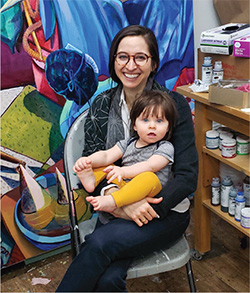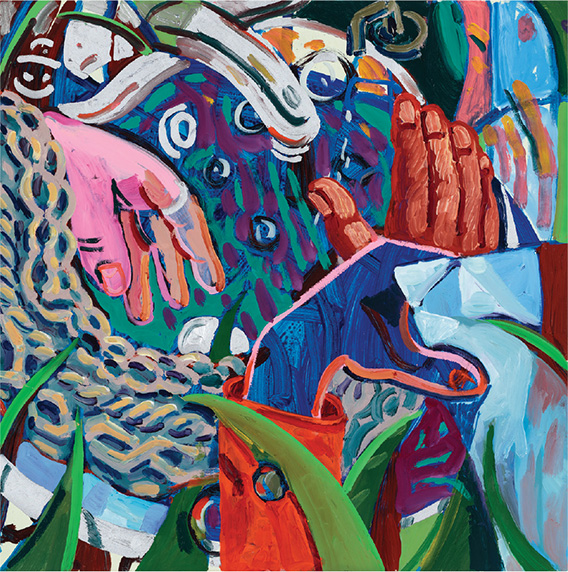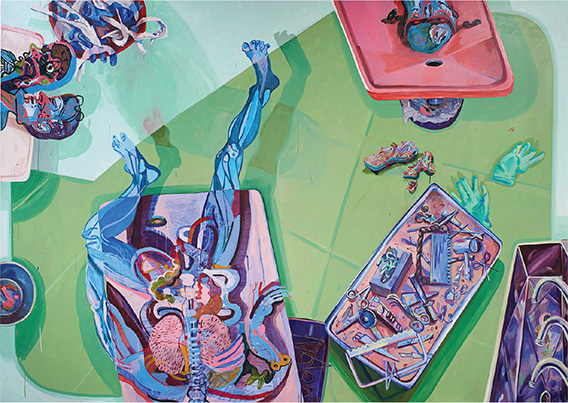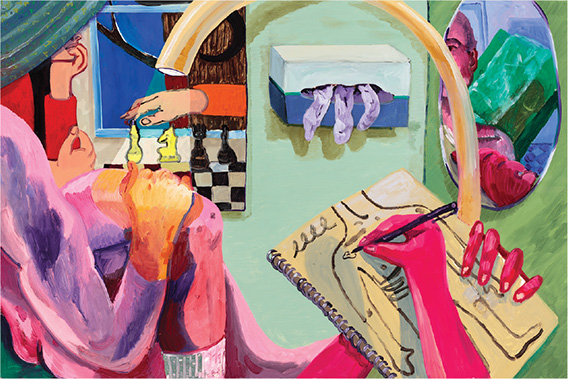Alumni Profile
 Sharon Madanes and her daughter, Sage, in her painting studio
Sharon Madanes and her daughter, Sage, in her painting studioIn the paintings of Sharon Madanes’19, limbs and torsos take precedence over faces, as banal actions like washing, pointing, and twisting are linchpins upon which the entire experience of a hospital turns. Her highly saturated hues and frenetic marks reveal an uninhibited flourish. No doubt that, while completing the requisite study hours and clinical rounds, moments in front of a canvas were precious. She made many small and large-scale works during medical school, which were exhibited in New York City, Los Angeles, and London galleries.
Artists Sharon Madanes and Julia Hickey met in art school as undergraduates, where they shared a painting studio. Overlapping again for a semester at VP&S, with Ms. Hickey as the incoming staff writer for the VP&S Alumni Association, was a coincidence too timely to pass up, so the two took a long walk through Washington Heights on a cold January afternoon to talk about painting and medicine and the possible shape of a physician painter’s life.
Julia Hickey (JH):What’s in your studio now?
Sharon Madanes (SM): I am making a lot of work about the experience of waiting. Maybe it’s because I am in this state of limbo, finishing residency interviews and waiting for the match. But I think that waiting is such a large part of medicine and the patient experience. I read this book called “Eros and Illness” that Rita Charon, the Columbia scholar who initiated the field of narrative medicine, recommended to me. In this book, David Morris talks about living with a wife who has Alzheimer’s. He describes it as “intransitive waiting.” It’s not about waiting for something, but waiting as an active state of being, with no object. It’s an idea I am thinking about a lot. Right now that is manifested as paintings of waiting spaces and waiting by hospital beds. I am also really interested in this idea of being inside and outside of something at the same time. One thing that’s really interesting about medical training is that you wear different hats and pretend to be something you are not for a short period of time. It’s really a rare and unique thing to say “Oh, I am going to play an ob/gyn for six weeks” or pretend to be a pediatrician or surgeon. You completely wear that identity, but at the same time you are removed. So that distance gives you space to observe and think about things. And it’s that distancing space that I think is the same space art occupies.
JH:So you find painting as a place to translate that distance?
SM: The distance is just required in order to make observations and think about things in a critical way. Being on a plastic surgery rotation and thinking about a breast augmentation surgery brought into play all these questions of culture and aesthetics. Or I got really interested in hand-washing because it’s this action you do over and over again in the hospital. I started thinking about it as a way of differentiating the self from “other” and what it signifies to patients. How does hand-washing structure chapters of time in your day?
 “The Checklist,” oil and acrylic on panel, 16”x16”, 2016
“The Checklist,” oil and acrylic on panel, 16”x16”, 2016JH:How do you move from an abstract concept to an object that is a painting?
SM:I think painting is just my way of thinking. And oftentimes, my way of thinking is not verbal. It’s visual. You see something and you understand it on a different level, or it creates a feeling. And so I’ll have a sort of visual thought while I’m on a rotation, and then I’ll translate that into painting. Painting is like poetry in a sense. I think that poetry is incredible because of the leaps you have to make to fill in the gaps. Poetry exists in what is unsaid. Where the visual thought or painting takes you is sometimes scrutable, and sometimes it’s unpredictable and very inscrutable.
JH:There is some visual static out of which your images emerge. In some hand-washing paintings, not every finger will be the same color, but the hands come together in your vision.
SM:If you see realistic paintings in real life, especially frescos, they are so loose up in person. They really dissolve into random marks. I think what painting can do is reveal how you see things and how perception works. Because you don’t actually see everything. Your mind fills in those gaps, and your mind creates things.
JH:Can you tell me about a specific painting?
SM: I made a painting while I was in the first-year anatomy course. We had one lab where the body was transected in two different ways, sagittally and coronally. Like down the middle one way and then the other way. So my painting has three figures in it. Two heads are cut in those ways. And then, the third figure’s head is “cut” by the canvas, by cropping. The painting is called “Cut Three Ways,” because it plays with the idea of a physical cut, but then also a more metaphorical cut, or a type of headlessness that is required for the medical student to see beyond the violence of dissection to the knowledge, the anatomy. I painted the figures loosely, with lines, because in that period of medical training you learn to translate a 2D anatomical diagram onto a real body. And that experience of translation is also something you do in art all the time.
JH:Why do you make such colorful paintings?
SM: I think it’s because color gives off an intensity of feeling and elicits intensity in the viewer. I am interested in discovering color relationships, in how colors vibrate and talk. Right now color serves a totally different function in my paintings than before medical school, because color in the hospital is so particular—the color of the uniforms, the linoleum, the curtains, the walls, the light. I can only speculate why these decisions were made. In some spaces, it seems like everything is green, like in the old anatomy lab. Or in the operating room, you drape everything with blue fabric. You used to wear blue scrubs until Columbia changed to maroon. I don’t know if that’s because blue is the opposite of the color of flesh and insides or just a peaceful hue. All of a sudden I started having a whole different color experience than I did before, and maybe that’s why so many of my paintings are blue. That is something I had to try to break away from actively, because I was painting all green and blue! And pink, and hot red. Because that was what I was seeing.
 “Cut Three Ways,” oil and acrylic on canvas, 90”x120”, 2015
“Cut Three Ways,” oil and acrylic on canvas, 90”x120”, 2015JH:Talk about your choice to go into psychiatry.
SM: When I first came to medical school, I thought I would go into psychiatry. But on clinical rotations, being a visual thinker really drew me to surgery. And the operating room was an arena where I felt very comfortable. In art school I loved power tools and was always in the wood shop. In surgery, you are fixing a problem by working with your hands. And I loved collaborating with other people. It reminded me of working as an artist assistant, which is a job I had for a few years. Many of the things that excited me about the operating room, however, were being satisfied by my studio practice—that itch was being scratched by painting. Ultimately I realized that so much of what drives me, and what brought me to medical school in the first place, is thinking about patient stories, about the psychology of experiences, about the way the brain works and mental health. I wanted to spend time talking to patients. I think I could have been a surgeon-painter in another lifetime. I think in psychiatry there is this chance to really have a deep connection with somebody else and think through problems with another person in a rewarding way that does justice to artistic thought.
JH:What about the perception that being an artist or a doctor is a calling and that people can’t possibly be both to a serious degree?
 “Clinic Chess,” oil on panel, 24”x32”, 2018
“Clinic Chess,” oil on panel, 24”x32”, 2018SM:There are models for being both, especially in writing. There aren’t so many models for that with painting. Verbal language is something that is used all the time in medicine, obviously. I think visual language is also used all the time in medicine, but maybe it’s not as acknowledged. I think everybody, no matter how serious they are about their career, wears multiple hats and multiple professional hats, too. Like many artists are also very serious teachers, and same goes for physicians. But I also think it extends to people’s personal lives. There are so many physicians who are also mothers or fathers or children to elderly parents. Everybody has so many demands on their time, and demands on their selves, that to tell somebody that there is only space to be one of your selves is just not doing justice to what it means to be human. Right now the profession of medicine is facing a burnout crisis, and I think part of that is not allowing doctors to be people in multiple ways. I know being a physician is very demanding on your time and on your energy. Taking care of and caring for anybody is really challenging. But I think that there needs to be space, at least over the span of a career, to be a whole person, and that means allowance to wear different hats. At different points in your life you will have more or less time to do certain things. But there just has to be some kind of nod that that those different selves exist and that they are important.
Sharon Madanes’19, who attended the Skowhegan School of Painting and Sculpture in 2014, has an MFA in fine art from Hunter College (2014) and a BA in art from Yale University (2007). She is co-founder of 14 x 48, a nonprofit organization that displays works by contemporary artists on vacant billboards across New York City. Dr. Madanes matched to a psychiatry residency at NYU. See more of her work at www.sharonmadanes.com.
- Log in to post comments

